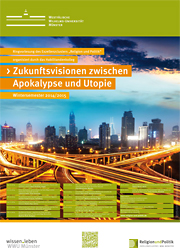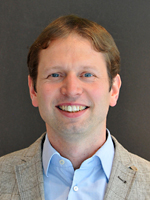вҖңThe 21st century is no longer familiar with positive utopiasвҖқ
Researchers analyse visions of the future from antiquity until today вҖ“ lecture series of the Cluster of Excellence on apocalypse and utopia, starting 14th October in MГјnster, Germany
Press release of the Cluster of Excellence, 2 October 2014

According to the assessment of cultural scientists, the 21st century is no longer familiar with positive social utopias in literature, arts and politics. вҖңInstead, the challenges of the future such as climate change and digitalisation are often depicted in an apocalyptic language and rhetorically linked to the end of the worldвҖқ, explains literary scholar Dr. Christian Sieg from the University of MГјnsterвҖҷs Cluster of Excellence вҖңReligion and PoliticsвҖқ in Germany. вҖңIn the light of economic crises, wars and environmental disasters, we have for decades been looking to the future with scepticism.вҖқ There are rather few positive visions of the future. вҖңToday, hardly any people buy into the utopian master narratives of the previous century such as socialism or the belief in progress by technology.вҖқ The scholar announces the ClusterвҖҷs coming public lecture series on вҖңVisions of the Future between Apocalypse and UtopiaвҖқ.
Organised by the Cluster of ExcellenceвҖҷs postdoctoral programme, the lecture series will begin on 14th October. It will address the history of apocalyptic and utopian thinking from antiquity until today. The topics will range from prophetic texts from ancient Egypt, philosophical concepts of the future and Richard WagnerвҖҷs вҖңThe Artwork of the FutureвҖқ to female Spanish FascistsвҖҷ utopian image of woman. Green utopias of the present and cinematic narratives like вҖңAvatarвҖқ and вҖңCloud AtlasвҖқ will also be examined. The lectures will be held on Tuesdays from 18:15 to 19:45 p.m. in lecture theatre F2 of the FГјrstenberghaus, Domplatz 20-22.
Unknown island of Utopia

Dr. Christian Sieg
According to Christian Sieg, вҖңGlobalisation has gathered the world so closely together that it is difficult today to still imagine an unknown place вҖҳUtopiaвҖҷ as a model for an ideal futureвҖқ. вҖңAt best, desires are associated with colonising faraway Mars. We no longer dare to conceive universal utopias. The idea of being able to do things completely different and far better has lost in plausibility, which is also due to our historical knowledge of problems in building ideal societies.вҖқ People today are at best looking for solutions for the future in subdomains such as environmental protection or human rights.
English statesman and author Thomas More (1475-1535) described as вҖңUtopiaвҖқ (вҖңno-placeвҖқ) a fictitious island with ideal social conditions, thus criticising the conditions in Europe at that time, the expert explains. вҖңEver since More, utopias have served as alternative drafts to a contemporary society.вҖқ At best, utopian visions today are conceivable as fairy tales, and films such as вҖңAvatarвҖқ borrow from their ideas. вҖңThe seriesвҖҷ 14 lectures will show that apocalypse and utopia are two historically significant visions of the future, which created images and narratives that persist today.вҖқ Representatives from the fields of history, law, political science, German studies, philosophy, theology, archaeology, Egyptology and musicology will speak in the lecture series.
вҖңPeople have always given thought to the future, availing themselves of different mediaвҖқ, according to Christian Sieg. вҖңThe oral accounts of visions were joined by literature, music, film and architecture.вҖқ Early examples are the accounts of visions in the New Testament. вҖңJohnвҖҷs apocalypse describes a concept of salvation which was to comfort the oppressed Christians in the Roman Empire. Here, the end of the world becomes the beginning of a new, better age, the Heavenly Jerusalem.вҖқ This idea is in many cases also reflected in architecture, as the scholar argues using an example from the lecture series: вҖңIn the early modern period, urban planning was in some cases guided by descriptions of the Heavenly Jerusalem. Cities thus became a sacral space.вҖқ
Until today, literature has also resorted to the BibleвҖҷs apocalyptic motifs, as the literary scholar explains. The stereotypical phrase of the visionвҖҷs account вҖңI sawвҖқ can be found in GГјnter GrassвҖҷ вҖңThe RatвҖқ (1986), for example. The emotional reaction to dreams and prophecies that is typical of biblical prophets is taken up in Christa WolfвҖҷs вҖңCassandraвҖқ (1983). вҖңThe modern age, however, often uses the term вҖҳapocalypseвҖҷ differently from the Bible. It no longer refers to a promise of salvation but is equated with the final end of the world. There is a rudimentary post-apocalyptic life at the most, as many science fiction books and films such as вҖҳThe Day AfterвҖҷ (1983), вҖҳI Am LegendвҖҷ (2007) or вҖҳThe RoadвҖҷ (2009) show.вҖқ
вҖңThe drafts of the futureвҖҷs political and religious functions are just as manifold as the media which transport themвҖқ, underlines the cultural scientist. Hence, many 20th-century utopias served as warnings of threats or as alternative drafts to a present that people wanted to change. In history, visions for the future also served to secure hegemony, as was the case with the First Crusade, which was justified as a Biblical eschatological battle. The National Socialist propaganda term вҖңThousand Year ReichвҖқ also stood in the tradition of apocalyptic conceptions. вҖңAfter all, drafts of the future also served as a religious articulation of the afterlife, as did those visions that were reflected in ancient tomb portraits. By using examples like these, the lecture series will illustrate how religious and political elements are interwoven in visions of the future.вҖқ (vvm/ska)
Programme
| 14.10.2014 | Klaus Vondung (Siegen) | Utopische EntwГјrfe вҖ“ apokalyptische Visionen: TrГӨume vom besseren Leben? |
| 21.10.2014 | Catherine Keller (Drew University) | Klima-Apokalypse, grГјne Utopie: Auf dem Weg zu einer Politischen Theologie der Erde |
| 28.10.2014 | Joachim Friedrich Quack (Heidelberg) | Prophetische Texte aus dem griechisch-römischen Ägypten |
| 04.11.2014 | Rubina Raja (Aarhus) | Zukunftsvisionen im Grab. GrabportrГӨts und Gesellschaft in Palmyra |
| 11.11.2014 | Jay Rubenstein (University of Tennessee) | Nebuchadnezzar's Dream: Apocalypse, History, and the First Crusade |
| 18.11.2014 | Matthias Riedl (Budapest) | Die Welt als Kloster вҖ“ Joachim von Fiore und sein Verfassungsentwurf fГјr die zukГјnftige Menschheit |
| 25.11.2014 | Liliya Berezhnaya (MГјnster) | Wie man eine Heilige Stadt baut: вҖһNeue JerusalemsвҖң im osteuropГӨischen Raum der FrГјhen Neuzeit |
| 02.12.2014 | Maren Conrad (MГјnster) | Nach dem Ende вҖ“ Postapokalyptische Visionen in Literatur, Film und Computerspiel des 21. Jahrhunderts |
| 09.12.2014 | Wolfram Steinbeck (KГ¶ln) | WelterlГ¶sungsutopien: Richard Wagner und вҖһDas Kunstwerk der ZukunftвҖң |
| 16.12.2014 | Andreas Urs Sommer (Freiburg) | Utopische Geschichtsphilosophie вҖ“geschichtsphilosophische Utopik |
| 06.01.2015 | Toni Morant i AriГұo (MГјnster) | вҖһDie groГҹen Tage kommenвҖң: Zum utopischen Staats- und Frauenbild der spanischen Faschistinnen |
| 13.01.2015 | Josef FrГјchtl (Amsterdam) | Neue groГҹe ErzГӨhlungen: Das Kino von вҖһAvatarвҖң und вҖһCloud AtlasвҖң |
| 20.01.2015 | Tatjana Hörnle (Berlin) | Die Zukunft des Strafens in multikulturellen Gesellschaften |
| 27.01.2015 | Antje FlГјchter (Bielefeld) | Indien im вҖһWarteraum der GeschichteвҖң? Wie der Westen zur Zukunft der Welt wurde |
Winter semester 2014/2015
Tuesdays,6.15 bis 7.45 p.m.
Lecture hall F1 at the FГјrstenberghaus
Domplatz 20-22
48143 MГјnster

